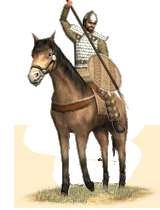Asabârân-î Mâdâën (Median Medium Cavalry)
 |
Weapons | Defence | Mental | ||||||
|---|---|---|---|---|---|---|---|---|---|
| Primary | Secondary | Armour: | 8 | Morale: | 11 | ||||
| Type: | spear | axe | Shield: | 2 | Discipline: | impetuous | |||
| Attack: | 8 | 7 | Skill: | 8 | Training: | trained | |||
| Charge: | 27 | 15 | Recruitment | Other | |||||
| Lethality: | 0.15 | 0.165 | Soldiers: | 25 | Hit Points: | 1 | |||
| Range: | 0 | 0 | Cost: | 2176 | Mass: | 1 | |||
| Ammo: | 0 | 0 | Upkeep: | 544 | |||||
| Turns: | 1 | ||||||||

Armoured in scale cuirasses, Asabârân-î Mâdâën are equipped with spears and vicious Tabar axes. These horsemen are excellent medium cavalry, capable of skirmishing, charging, and fighting fairly well in melee.
Impetuous
In the Seleucid and Bactrian armies, these medium Median cavalrymen are very prevalent. Descended from the lesser Persian nobility they now render good service to their new masters. They are excellent medium cavalry, capable of skirmishing, charging, and fighting fairly well in melee. These cavalry are raised from the old Persian estates that had not seized by the Macedonian invaders. They are equipped with a cavalry spear and the single bladed Tabar axe with a vicious back-spike, well capable of penetrating heavy armor. The battle-axe was often used, especially by North Iranians. The spear was usually used over arm as a thrusting weapon. The shield used by these horsemen was the crescent shaped Scythian Taka shield. A conical Persian helmet of iron is worn with brightly colored helmet plume. Their armor is a scale cuirass with scaled shoulder guards and stiffened leather pteruges hanging from the waist. Loose richly embroidered trousers and a long sleeved tunic extending down to just above the knees, is secured by a leather belt. The horse has a stuffed Persian saddle and thick, bright colored saddle cloth. The tails were tied up to prevent it being grabbed by the enemy. The forelock was left long and tired with ribbon to form a plume above the head.
Historically; The Macedonians came to Persia as invaders, sharing neither a common culture nor a common enemy. These lesser nobles are quick to make cause with any rebel, and the Greek upper class know this well. The Seleucids, and Baktrians intent on Hellenizing Iran, cannot rely on these men who are descended from a proud tradition, the Huvaka, Kinsmen cavalry who had faced Alexander the Great during late imperial times. It is for this reason that the Greeks often preferred to rely on mercenaries and Greek settlers, but these men are still able to be used in some roles and are conscripted in times of need. Some of these minor noble houses have intermarried with their Macedonian overlords and are thus somewhat more loyal than their neighbours might be. Still, they are often present in native revolts, due to the fact that they can often lead these revolts and have fewer opportunities due to their Iranian blood.